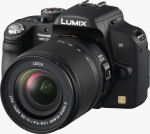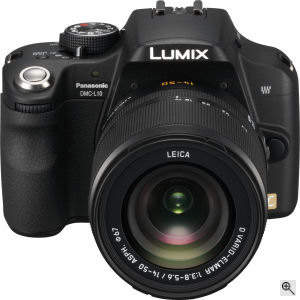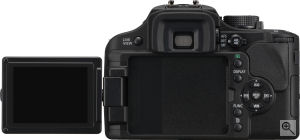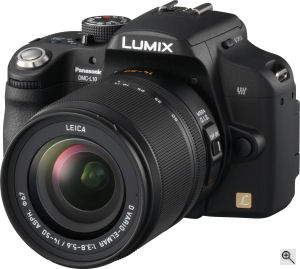 Panasonic: DSLR has live view w/ AF, face detection, articulated LCD
Panasonic: DSLR has live view w/ AF, face detection, articulated LCD
By
Mike Tomkins
(Thursday, August 30, 2007 - 10:00 EDT)
Eighteen months after it announced its first single-lens reflex digital camera, Panasonic has today unveiled a new digital SLR and lens that will together have a somewhat more affordable pricetag.
While the original Lumix DMC-L1 featured retro styling, the Panasonic Lumix DMC-L10 offers a much more traditional "SLR look". Under the skin, the Lumix L10 is a lot more than a simple cost-cutting of the original model though. Some of the features really look to stand out from the crowd, especially those related to the camera's live view mode. Perhaps most significantly, Panasonic follows the lead set by Nikon recently in adding the ability to autofocus in live view mode by applying contrast detection to the data being clocked off the main image sensor. Ordinarily, the L10's phase difference detection AF system has three focusing points, but when you switch to contrast detection autofocus this increases to nine points. You can also manually select an AF point from 11 possible locations, or choose from a variety of AF point groups in a new Multi AF mode. Not only does the L10 have these AF modes, but it also offers face detection capable of detecting up to 15 faces in a scene. This is a first for a DSLR, and will allow the L10 to set focus and exposure correctly based on your subjects' faces when using Live View mode (note that face detection isn't functional when using the L10 as a traditional SLR). Another feature tied to the Panasonic L10's Live View mode is Panasonic's "Intelligent ISO Control" function, which monitors subject movement and then raises ISO sensitivity as necessary to achieve a blur-free image. Metering is also linked to the Live View mode, with metering regularly 49-zone, but switched to a more fine-grained 256-zone metering when framing subjects on the camera's 2.5" LCD display. That display itself is also designed to get the most out of Live View mode, being a tilt / swivel type that will let users hold the camera at pretty much any angle while still being able to see the LCD. (This is something for which we've heard countless requests from DSLR buyers over the years, and it will be interesting to see how the feature is adopted by users. One more feature tied into the live view mode is one we'd frankly not expected to see on a digital SLR any time soon - digital zoom. Either a 2x or 4x digital zoom are available, but we'd have to guess most users shooting with a DSLR would be more likely to make enlargements on a PC rather than in-camera. One note with all of the above: we don't currently know what the framerate of the DMC-L10's live view mode will be, and that will surely affect the usability of the live view-related features. That said, the fact that Panasonic has expended the effort in adding things like face detection in a digital SLR suggests there could be the promise of a live view mode that's truly useable outside of the photo studio. The Panasonic Lumix L10 is based around a 10.1 effective megapixel Live-MOS image sensor (Four Thirds lens mount / sensor format), which in concert with Panasonic's Venus Engine III image processor is capable of continuous shooting at up to three frames per second, albeit only up to a rather brief 3 RAW frames. JPEG shooters will be pleased to hear that there's no burst depth limitation on JPEG files however (presuming your flash cards are fast enough and you have flash card space / battery life remaining). Other features include a penta mirror type viewfinder, shutter speeds from 60 - 1/4000 second plus bulb, Secure Digital card storage, and power from a proprietary Lithium Ion battery. The Panasonic Lumix DMC-L10 will ship from October 2007, priced at about $1300 with a newly announced Panasonic LEICA D VARIO-ELMAR 14-50mm / F3.8-5.6 / MEGA O.I.S. zoom lens. This will be the second 14 - 50mm lens issued by Panasonic, and while it isn't as bright as the existing lens, it is said to be rather smaller and lighter (and we'd presume lower cost, as well, although Panasonic hasn't disclosed any plan to make the lens available separately). | Panasonic Lumix DMC-L10 |  | | General | | Camera Type | SLR | | Manufacturer | Panasonic | | Model Number | DMC-L10 | | Dimensions | 5.3 x 3.8 x 3.1"
134.5 x 95.5 x 77.5mm | | Weight | 480.0 g
16.8 oz | | Planned Price | $1299.95 | | Planned Availability | Oct 2007 | | Image Capture | | Sensor Type | Four Thirds N-MOS
11.80 megapixels (total)
10.10 megapixels (effective) | | Filter Type | RGBG | | Aspect Ratio | 4:3, 16:9 | | Image Dimensions | 3648 x 2736 (10.0 megapixels)
3648 x 2432 (8.9 megapixels)
3648 x 2056 (7.5 megapixels)
2816 x 2112 (5.9 megapixels)
2816 x 1880 (5.3 megapixels)
2816 x 1584 (4.5 megapixels)
2048 x 1536 (3.1 megapixels)
2048 x 1360 (2.8 megapixels)
1920 x 1080 (2.1 megapixels)
| | Capture Speed | Continuous: 3.0 frames per second for 3 frames | | Image Preview / Review | | Viewfinder | Yes, Eye level penta mirror type optical view finder
95% field of view | | LCD | 2.5", 207,000 pixels
100% field of view | | Playback Zoom | 16.0x max | | Lens | | Lens Type | Interchangeable Lens | | Lens Mount | Four Thirds mount | | Focusing System | Normally 3-point phase difference detection; can use 9-point contrast detection in live view mode with AF assist lamp | | Exposure | | ISO Sensitivity | Auto, 100, 200, 400, 800, 1600, Intelligent ISO* (Live View mode only) | | Shutter Speed | 60 - 1/4000 second | | Exposure Modes | Aperture, Shutter, Manual | | Metering Modes | Multi-patter n (Normally 49-zone, can be 256-zone in Live View mode), Center-weighted, Spot | | Exposure Compensation | +/- 2.0EV in 1/3EV increments | | White Balance | Image Sensor - Auto, Daylight, Cloudy, Shade, Halogen, Flash, White Set 1, White Set 2, Color Temperature Setting, Manual | | Internal Flash | Guide Number: 11
Modes: Auto, Auto/Red-eye Reduction, Forced On, Forced On/Red-eye Reduction, Slow Sync., Slow Sync./Red-eye Reduction, Forced Off
Range: Guide Number 11 (ISO100,m) | | Flash Exposure Compensation | +/- 2.0EV in 1/3EV increments | | Creative | | Scene Modes | Portrait, Scenery, Macro, Sports, Night Portrait, Baby 1, Baby 2, Pet, Sunset, Food | | Digital Zoom | 2x or 4x (Live View mode only) | | Self Timer | Yes, 2 or 10 seconds | | Storage | | Recording Medium | SD/MMC | | File System | Complies with Design Rule for Camera File System (DCF) | | File Format | CCD-RAW, JPEG (EXIF v2.21) | | Connectivity | | Video | Yes, NTSC / PAL switchable | | Computer | USB 2.0 Full (LOW) Speed | | Power | | Battery Type | Lithium Ion rechargeable | | Battery Form Factor | Proprietary | | Product Bundle | | Software | LUMIX Simple Viewer, PhotofunStudio -viewer-, SILKYPIX DEVELOPER STUDIO, USB Driver | | Battery / Charger | 1 x Proprietary Lithium Ion rechargeable battery and charger | | Flash Memory | 0.0MB | | Other | | Digital Print Order Format (DPOF) compliant | Yes | | PictBridge Compliant | Yes | | Internal Microphone | No | | Tripod Mount | Yes | | Remote Control | Yes, Optional DMW-RSL1 cable remote | | More Photos |  |  | | |
|
Original Source Press Release:
| PANASONIC EXPANDS LUMIX SLR LINE WITH FIRST SLR MODEL FEATURING FACE DETECTION, ADVANCED INTUITIVE FEATURES LUMIX DMC-L10 Features 270-Degree Rotating Live View LCD, and Advanced Dust-Prevention System SECAUCUS, N.J. (August 30, 2007) – Panasonic today introduced the newest member of its digital single-lens reflex (SLR) camera line, the Panasonic LUMIX DMC-L10, the company’s first SLR with Face Detection. The DMC-L10 also offers an advanced 2.5 inch Live View LCD which can rotate 270 degrees, enabling versatile shooting options, and making it easy and convenient to shoot from high or low angles. Complete with a 10.1-megapixel Live MOS Sensor, the DMC-L10 includes an advanced, Supersonic Wave Filter system that prevents dust from collecting on the sensor and degrading photo quality. “Panasonic’s advanced digital imaging technologies, including Optical Image Stabilization and Intelligent ISO control settings, are helping LUMIX compact digital cameras make a name for themselves in this industry, “said Alex Fried, National Marketing Manager, Imaging, Panasonic Consumer Electronics Company. “Now, we expand our SLR line with the LUMIX DMC-L10, which is especially designed for the consumer who is familiar with compact digital cameras, but also wants to further experience the enjoyment of digital SLR photography.” The DMC-L10 is Panasonic’s first digital SLR with Face Detection, which will focus, set auto exposure and can detect up to 15 human faces simultaneously, capturing the subjects clearly and brightly. Combining Face Detection with Panasonic’s Intelligent ISO Control settings, which measures the movement of the subject and sets the ISO level accordingly, helps give consumers crisp, blur-free images. The Live View LCD lets users check the image on the camera after making exposure compensation adjustments, but before taking the shot. The LCD also features an Intelligent LCD function that offers an automatic brightness level control function, making the screen visible regardless of a bright sunlit or dark environment. In addition, the DMC-L10 adopts advanced hybrid-type AF system, which gives users the option to choose either the phase difference AF system or the contrast AF to suit the preferred shooting style. While in manual mode, the user can enlarge part of the subject on LCD and also freely move the magnified area for easy framing. A common concern among digital SLR camera users is the potential of dust entering the camera’s body when adjusting interchangeable lenses. To combat this, Panasonic has equipped the DMC-L10 with a Supersonic Wave Filter system that uses supersonic vibrations to shake off dust clinging to the sensor, which also simplifies the maintenance process. The DMC-L10 incorporates a variety of functions that build a bridge for those transitioning from a compact digital camera to a digital SLR, helping them to take high-quality digital photos. For instance, the Mode Dial on top of the camera provides easy access to the most frequently used settings including Auto mode, each P/A/S/M mode, and five scene modes (Portrait, Scenery, Macro, Sports and Night Portrait) and one custom mode that can be set per the user’s preference. The DMC-L10 comes equipped with a LEICA D VARIO-ELMAR 14-50mm / F3.8-5.6 / MEGA O.I.S. lens, which has a focal length from 14mm to 50mm, and offers a more compact and light-weight body than its predecessor (LEICA D VARIO-ELMARIT 14-50mm/ F2.8 -3.5 ASPH). Other advanced features of the Panasonic LUMIX DMC-L10 include: - Film Mode: Allows users to choose a setting which mimics the effects of analog film. Users select from nine modes including Standard, Dynamic, Nature, Smooth, Nostalgic, Vibrant, Standard B/W, Dynamic B/W and Smooth B/W, with the capability to finely adjust contrast, sharpness, saturation and noise reduction. All these settings can be confirmed before you take the picture and the result is always as you intended.
- The Venus Engine III: Image processing LSI developed by Panasonic to maximize the performance of the Leica D lens and Live MOS sensor. This advanced LSI helps reproduce images with outstanding resolution, superior color and detailed gradation. It also distinguishes chromatic noise from luminance noise and selectively reduces the chromatic noise, one of the chief sources of image quality problem. This helps the DMC-L10 deliver the superb image rendering one expects from a quality SLR camera.
- Image Stabilization: Panasonic drew on its cutting-edge lens technology to invent Mega O.I.S. (Optical Image Stabilizer), a system that prevents blurring from shaky hands and has been incorporated in the full 2007 line of LUMIX digital cameras. This high-precision image stabilizing lens system is now available with the LEICA D VARIO-ELMAR 14-50mm/F3.8-5.6/MEGA O.I.S.
- Advanced Scene Modes: As part of the L10’s intuitive usability, the photographer can make finer adjustments when using frequently-used scenes such as Portrait, Sports, Landscape and Night portrait. For instance, when selecting the Portrait or Sports mode, users can further define whether the scene is in outdoors or indoors. When using the Landscape mode, users can specify if it is a nature or an architectural shot.
- Auto-Focusing Methods: To match the shooting situation and subject's position, the user can select from six auto-focusing methods: Face Detection, 9-point, Multi, 3-point, 1-point and Spot. With the 1-point AF or spot AF method, the auto-focusing area can be chosen from as many as 11 points. Various group area patterns can also be selected in the new Multi method.
The Panasonic LUMIX DMC-L10 will be available in October 2007 for a MSRP of $1,299.95. About Panasonic Consumer Electronics Company
Based in Secaucus, N.J., Panasonic Consumer Electronics Company is a Division of Panasonic Corporation of North America, the principal North American subsidiary of Matsushita Electric Industrial Co. Ltd. (NYSE: MC) and the hub of Panasonic's U.S. marketing, sales, service and R&D operations. In its commitment to provide consumers with extensive imaging resources, Panasonic LUMIX established the Digital Photo Academy, a series of nationwide workshops designed to instruct consumers how to optimize the features on their digital cameras and produce high-quality photos. Panasonic is honored to support OUR PLACE – The World’s Heritage, a project that will create the world’s largest photographic collection of UNESCO World Heritage sites, with acclaimed photographers exclusively using LUMIX digital cameras to capture all images. Information about Panasonic LUMIX digital still cameras and its affiliated programs is available at www.panasonic.com/dsc. # # # |
|